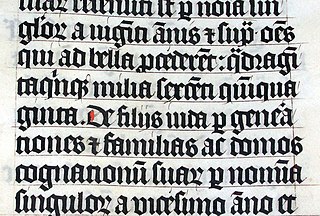
A diacritic is a glyph added to a letter or to a basic glyph. The term derives from the Ancient Greek διακριτικός, from διακρίνω. The word diacritic is a noun, though it is sometimes used in an attributive sense, whereas diacritical is only an adjective. Some diacritics, such as the acute ⟨ó⟩, grave ⟨ò⟩, and circumflex ⟨ô⟩, are often called accents. Diacritics may appear above or below a letter or in some other position such as within the letter or between two letters.

M, or m, is the thirteenth letter of the Latin alphabet, used in the modern English alphabet, the alphabets of other western European languages and others worldwide. Its name in English is em, plural ems.

V, or v, is the twenty-second letter of the Latin alphabet, used in the modern English alphabet, the alphabets of other western European languages and others worldwide. Its name in English is vee, plural vees.
The Coptic script is the script used for writing the Coptic language, the most recent development of Egyptian. The repertoire of glyphs is based on the uncial Greek alphabet, augmented by letters borrowed from the Egyptian Demotic. It was the first alphabetic script used for the Egyptian language. There are several Coptic alphabets, as the script varies greatly among the various dialects and eras of the Coptic language.

In a Western context, Uncial is a majuscule script commonly used from the 4th to 8th centuries AD by Latin and Greek scribes. Uncial letters were used to write Greek and Latin, as well as Gothic, and are the current style for Coptic and Nobiin.

The Russian alphabet is the script used to write the Russian language. It comes from the Cyrillic script, which was devised in the 9th century for the first Slavic literary language, Old Slavonic. Initially an old variant of the Bulgarian alphabet, it became used in the Kievan Rusʹ since the 10th century to write what would become the modern Russian language.

In writing and typography, a ligature occurs where two or more graphemes or letters are joined to form a single glyph. Examples are the characters ⟨æ⟩ and ⟨œ⟩ used in English and French, in which the letters ⟨a⟩ and ⟨e⟩ are joined for the first ligature and the letters ⟨o⟩ and ⟨e⟩ are joined for the second ligature. For stylistic and legibility reasons, ⟨f⟩ and ⟨i⟩ are often merged to create ⟨fi⟩ ; the same is true of ⟨s⟩ and ⟨t⟩ to create ⟨st⟩. The common ampersand, ⟨&⟩, developed from a ligature in which the handwritten Latin letters ⟨e⟩ and ⟨t⟩ were combined.

The Early Cyrillic alphabet, also called classical Cyrillic or paleo-Cyrillic, is an alphabetic writing system that was developed in Medieval Bulgaria in the Preslav Literary School during the late 9th century. It is used to write the Church Slavonic language, and was historically used for its ancestor, Old Church Slavonic. It was also used for other languages, but between the 18th and 20th centuries was mostly replaced by the modern Cyrillic script, which is used for some Slavic languages, and for East European and Asian languages that have experienced a great amount of Russian cultural influence.

Church Slavonic is the conservative Slavic liturgical language used by the Eastern Orthodox Church in Belarus, Bulgaria, North Macedonia, Montenegro, Poland, Ukraine, Russia, Serbia, the Czech Republic and Slovakia, Slovenia and Croatia. The language appears also in the services of the Russian Orthodox Church Outside of Russia, the American Carpatho-Russian Orthodox Diocese, and occasionally in the services of the Orthodox Church in America.

The Cyrillic I is a letter used in almost all modern Cyrillic alphabets with the exception of Belarusian.

O is a letter of the Cyrillic script.

Scribal abbreviations, or sigla, are abbreviations used by ancient and medieval scribes writing in various languages, including Latin, Greek, Old English and Old Norse.

Izhitsa is a letter of the early Cyrillic alphabet and several later alphabets, usually the last in the row. It originates from the Greek letter upsilon and was used in words and names derived from or via the Greek language, such as кѵрилъ or флаѵии. It represented the sounds or as normal letters и and в, respectively. The Glagolitic alphabet has a corresponding letter with the name izhitsa as well. Also, izhitsa in its standard form or, most often, in a tailed variant was part of a digraph оѵ/оу representing the sound. The digraph is known as Cyrillic "uk", and today's Cyrillic letter u originates from its simplified form.

Fita is a letter of the Early Cyrillic alphabet. The shape and the name of the letter are derived from the Greek letter theta (Θ θ). In the ISO 9 system, Ѳ is romanized using F grave accent (F̀ f̀).

Omega is a letter used in the early Cyrillic alphabet. Its name and capital form are derived directly from the Greek letter Omega (Ω ω).

Cyrillic numerals are a numeral system derived from the Cyrillic script, developed in the First Bulgarian Empire in the late 10th century. It was used in the First Bulgarian Empire and by South and East Slavic peoples. The system was used in Russia as late as the early 18th century, when Peter the Great replaced it with Arabic numerals as part of his civil script reform initiative. Cyrillic numbers played a role in Peter the Great's currency reform plans, too, with silver wire kopecks issued after 1696 and mechanically minted coins issued between 1700 and 1722 inscribed with the date using Cyrillic numerals. By 1725, Russian Imperial coins had transitioned to Arabic numerals. The Cyrillic numerals may still be found in books written in the Church Slavonic language.
The grave accent is a diacritical mark used to varying degrees in French, Dutch, Portuguese, Italian, Catalan and many other western European languages as well as for a few unusual uses in English. It is also used in other languages using the Latin alphabet, such as Mohawk and Yoruba, and with non-Latin writing systems such as the Greek and Cyrillic alphabets and the Bopomofo or Zhuyin Fuhao semi-syllabary. It has no single meaning, but can indicate pitch, stress, or other features.

In Christian scribal practice, nomina sacra is the abbreviation of several frequently occurring divine names or titles, especially in Greek manuscripts of the Bible. A nomen sacrum consists of two or more letters from the original word spanned by an overline.
Geresh is a sign in Hebrew writing. It has two meanings.
- An apostrophe-like sign placed after a letter:
- A note of cantillation in the reading of the Torah and other Biblical books, taking the form of a curved diagonal stroke placed above a letter.
As the 9th-century missionaries Saints Cyril and Methodius undertook their mission to evangelize to the Slavs of Great Moravia, two writing systems were developed: Glagolitic and Cyrillic. Both scripts were based on the Greek alphabet and share commonalities, but the exact nature of relationship between the Glagolitic alphabet and the Early Cyrillic alphabet, their order of development, and influence on each other has been a matter of great study, controversy, and dispute in Slavic studies.




















